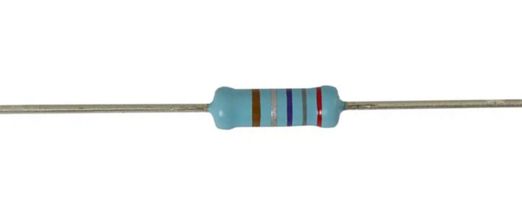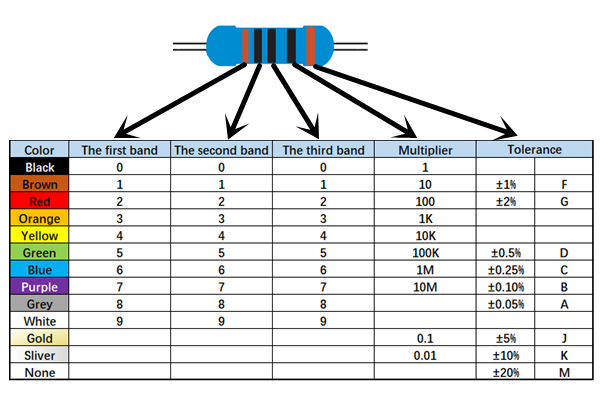Resistors with color bands are a practical way for users to determine their resistance value without the need for a multimeter. This system is commonly used on cylindrical resistors, such as carbon film, metal film, metal oxide film, fuse, and wire-wound resistors. These components typically have either four, five, or six color bands that represent the resistance value, tolerance, and sometimes even temperature coefficient.

Color-coded resistors are among the most frequently used components in electronic circuits. They are marked with colored bands on their body to indicate their resistance value. The units used are ohms (Ω), kilo-ohms (kΩ), and mega-ohms (MΩ). For reference, 1 MΩ equals 1,000 kΩ or 1,000,000 Ω.
The most common types of color-coded resistors are four-band and five-band. Four-band resistors are more widely used in general applications. In a four-band resistor, the first two bands represent the significant digits, the third band is the multiplier, and the fourth band indicates the tolerance. Five-band resistors follow a similar pattern but include an extra digit for greater precision. Tolerance is usually indicated by gold (5%), silver (10%), or brown (1%). If no band is present, it means a 20% tolerance, and occasionally green may be used for 0.5%.

How to Identify Four-Band Resistors
A four-band resistor uses four colored bands to show its resistance value. Starting from the left, the first band is the first digit, the second band is the second digit, the third band represents the multiplier, and the fourth band shows the tolerance. When it's difficult to tell which band is first, look at the fourth band—gold or silver usually appears there. This rule only applies to four-band resistors.
Examples:
- Red, Yellow, Brown, Gold: 24 × 10 = 240 Ω, Tolerance: 5%
- Green, Red, Yellow, Silver: 52 × 10,000 = 520 kΩ, Tolerance: 10%
How to Identify Five-Band Resistors
Five-band resistors are designed for higher precision. The first three bands represent the significant digits, the fourth band is the multiplier, and the fifth band shows the tolerance. These resistors are often used in circuits where accuracy is essential.
Example: Red, Red, Black, Black, Brown: 220 × 1 = 220 Ω, Tolerance: 1%
How to Identify Six-Band Resistors
Some resistors have six color bands. The first five bands are interpreted the same way as in a five-band resistor, while the sixth band indicates the temperature coefficient. These resistors are used in specialized applications where environmental conditions affect performance. Although less common, they play an important role in high-precision electronics.
Stainless Steel Flanges And Fittings
TIANJIN JIAYI STEEL CO.LTD , https://www.jiayisteel.com